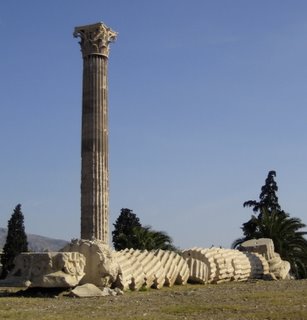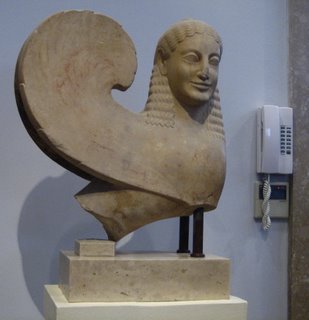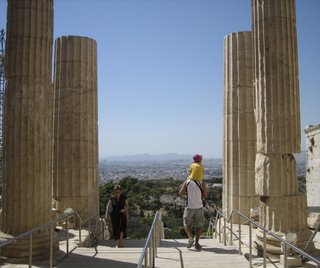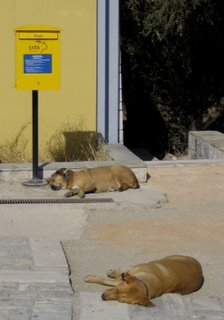
Seven thousand years old and still under construction!
At least one American Tourist (and probably more) was decidedly peeved to find so much scaffolding in evidence. It is the age-old conundrum faced by those attempting to conserve and restore iconic historical sites - how do you do what has to be done and not seriously disappoint the people whose entrance money you need to help pay for the work?
It must have been the same for all those Japanese tourists who visited London a month or two back and found Nelson’s Column concealed from view or the famous façade of St Paul’s Cathedral under wraps.
In the Disney theme parks they put up notices saying that an out-of-commission attraction is being “refurbished for your future enjoyment”, which is fine and dandy if you can pop back next month when it re-opens, but if you can’t then the disappointment can be crushing - I can still remember my very first visit to Disneyland and dashing to ‘The Pirates of the Caribbean’ ride only to find it “down for rehab”.
 In the case of the Acropolis, however, it’s worth remembering that, for quite a lot of its history, it has either been in the process of being built, altered, extended, knocked down or rebuilt and that if we could see the buildings that are now on the site as they were at the peak of perfection, we would still not be looking at the original Acropolis before the Persians took a sledgehammer to it, anymore than Sir Christopher Wren's version of St Paul’s Cathedral which every tourist wants to photograph without scaffolding and dust-sheets is actually the church that originally stood on that site before the Great Fire of London…
In the case of the Acropolis, however, it’s worth remembering that, for quite a lot of its history, it has either been in the process of being built, altered, extended, knocked down or rebuilt and that if we could see the buildings that are now on the site as they were at the peak of perfection, we would still not be looking at the original Acropolis before the Persians took a sledgehammer to it, anymore than Sir Christopher Wren's version of St Paul’s Cathedral which every tourist wants to photograph without scaffolding and dust-sheets is actually the church that originally stood on that site before the Great Fire of London…What is truly fascinating to consider, however, as you look at the modern cranes and equipment with the conservationists are working, is that the builders of 447 BC achieved what they did using what we would now consider only rudimentary technology…
Having climbed to the entrance from the Plaka - itself no mean achievement for one who is both overweight and walking with a stick (although, as it turned out, there was no shortage of the halt and the lame on this particular pilgrimage!) - I found the prospect of climbing even further to the ancient monumental gateway entrance, the Propylaea, somewhat daunting.
The realization proved, initially, slightly worse than expectations as I was pushed and shoved by a jostling, stomping, clambering sea of visitors skidding and sliding on the perilously slippery marble stones with the usual frenetic rush-and-tear, hit-and-run philosophy of “Get-there-see-it-photograph-it-and-go…”

"What a f****** stupid place to stop!" growled an impatient Brit caught in the momentary log-jam which I caused by pausing to catch my breath. David helpfully pointed out that it was doubtless as crowded as this, or more so, when - on special feast days - the Ancient Greeks made their way up this selfsame incline to worship in Athena's temples. I have to say, I was unmoved by the analogy...
 The masses were furiously hustled along by tour-guides with identifying paddles or umbrellas held aloft (one which was decorated with a view of the Acropolis) who bawled facts, names and fragments of history at their largely non-listening followers…
The masses were furiously hustled along by tour-guides with identifying paddles or umbrellas held aloft (one which was decorated with a view of the Acropolis) who bawled facts, names and fragments of history at their largely non-listening followers…And how many of those wearing Nike t-shirts and baseball caps realized that the logo they sport with fashionable pride was taken from the Greek word for ‘victory’ and that their Nike trainers were actually helping them scramble their way past what was once the Temple of Athena Nike?
I frankly admit to being a Tourist Snob: refusing to see myself in the same category as the rest of the herd and devoutly wishing that I could visit such places without having to share it with anyone other than a few select friends who would only be allowed to come if their faithfully promised not to behave as though they were kids from Form 3c on a school-outing…
Anyway, having reached the top and with the Parthenon finally in view there was a new and unexpected diversion. Seated on the steps - spoiling 9 out of 10 tourist snaps - were guards who blew whistles and shouted fiercely at anyone transgressing the rules…

 We saw smokers being sent off the pitch; a bottle of Coke confiscated from a bemused visitor who was clearly obliviously unaware of the sticky and corrosive properties of Cola; and, most dramatically, a man who eagerly leapt onto one of the rubble of stones littering the lower steps of the Parthenon in order to pose for a photo taken by his wife.
We saw smokers being sent off the pitch; a bottle of Coke confiscated from a bemused visitor who was clearly obliviously unaware of the sticky and corrosive properties of Cola; and, most dramatically, a man who eagerly leapt onto one of the rubble of stones littering the lower steps of the Parthenon in order to pose for a photo taken by his wife.The couple were instantly the subject of a vociferous exchange with a terrier-like guard who demanded, firstly, that the camera be handed over and that the culprits leave the site and then - when they refused - threatened to summon the police and spoke loudly and urgently into a walkie-talkie…
The exchange went on for some time but no law enforcement officers ever arrived and the couple subsequently wandered off smugly eating a sandwich which, had they but known it, was in contravention of yet another rule: "It is forbidden to introduce food or animals into the Acropolis..."
 It is too trite to say that one is acutely aware of the closeness of history in a place such as this, but looking down on what remains of the Theatre of Dionysus and knowing that it was here that the plays of Aeschylus, Sophocles, Euripides and Aristophanes were first performed truly telescopes time…
It is too trite to say that one is acutely aware of the closeness of history in a place such as this, but looking down on what remains of the Theatre of Dionysus and knowing that it was here that the plays of Aeschylus, Sophocles, Euripides and Aristophanes were first performed truly telescopes time…As David pointed out, it is fascinating to think that the very first time an audience would have watched Aeschylus’ Agamemnon - the opening scene of which is set in the darkness just before dawn - it would have been acted out as night failed and the first rays of the rising sun provided the natural stage lighting for the unfolding tragedy…
It is a far from original thought, I am sure, but I was struck by the realization that Greek culture is one where the distinction between history and mythology is fascinatingly blurred and where gods and men share timescale and landscape...
This is particularly true of the neighbouring ruins of the Temple of Olympian Zeus. Dedicated to the supreme ruler of the pantheon, it took over 700 years to build and was only finally completed with the aid of the Roman Emperor Hadrian who - along with the mythic deity - was once honoured with colossal gold and ivory statues.

Of the original 104 columns with elaborately carved capitals that tower 17 meters into the azur sky, only fifteen now remain standing...


...a sixteenth, which was blown down in a gale in 1852, still lies along the ground like a fractured vertebrae.

All the guidebooks advise you to visit the sites - especially the Acropolis - early in the morning or late in the afternoon in order to avoid the relentless heat of the midday sun - and, allegedly, the hordes of trippers… This, however, is a fallacy! We arrived early and the place was uncomfortably seething. By one o’clock in the afternoon it was virtually deserted to the extent that it was now possible to avoid ruining one’s photos of the ruins with an untidy mass of humanity!
So, here are a few images (you can click on them to enlarge) from a day crowded with imagery...
Light and shadows...

Steel tracery...

Equine profile...

Coluum...

A spot of shade...

Art appreciation in the Acropolis Museum…

One of the "marbles" Elgin missed…

Tree and stone...

Sphinx & sphone…

Comings & goings...

The first panel of a frieze numbered III because, like the Elgin Marbles, panels I and II are in the British Museum, London. Is there really any serious argument about where these cultural works of rightfully belong?

Spell-check errors...


Sleeping watch-dog...

The moon viewed through the ruins of the Erechtheion, on the spot where Athena battled with Poseidon for the patronage of Athens...

[Images: © Brian Sibley & David Weeks]
2 comments:
Some beautiful photos in there, Brian. Wish I could be there!
Your experience sounds similar to mine, which I've only just realised was about 10 years ago (yikes!).
The scaffolding was all over the place then too, and the tourists just as horrible.
I came away grump (yeah, so what's new! ;-)) and unimpressed. Thankfully there's lots more to see away from the ignorant hordes.
Post a Comment